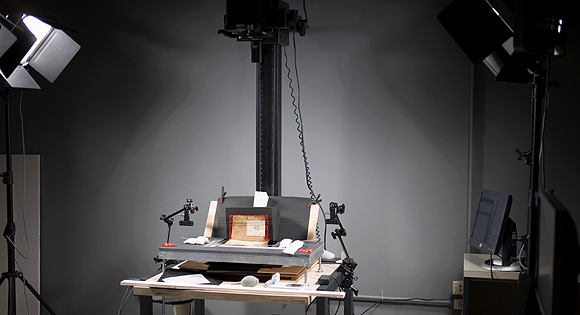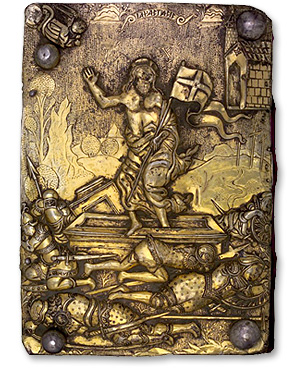| Sun | Mon | Tue | Wed | Thu | Fri | Sat |
|---|---|---|---|---|---|---|
| 1 | 2 | 3 | 4 | 5 | ||
| 6 | 7 | 8 | 9 | 10 | 11 | 12 |
| 13 | 14 | 15 | 16 | 17 | 18 | 19 |
| 20 | 21 | 22 | 23 | 24 | 25 | 26 |
| 27 | 28 | 29 | 30 | 31 |
CATEGORIES
RECENT ENTRIES
BLOG ROLL
Lights, camera, manuscript

Beneath tall, blazing lights that might illuminate a big-city fashion shoot, Manuscript 129 waits patiently for its close-up. Surrounded by velvety black curtains, in a dark corner of the Regenstein Library’s preservation department, photographer Michael Kenny sets up the shot. The compact, fragile volume—commonly known as the Nicolaus Gospels—still looks gorgeous, though its original provenance is 12th-century Greece.

Page by delicate page, Kenny photographs the manuscript with a digital camera, sending each image to a nearby PC. After a minute or so, he watches the scanned reproduction appear on his monitor. The quality of the 600-dpi image is sharp; zooming in, he can make the type even larger and clearer than the original. But photographing medieval texts is slow work, says Kenny: “Twenty-five or 30 pages is a good day.”
His efforts are part of an ongoing project to digitize the Edgar J. Goodspeed Manuscript Collection, a set of 68 New Testament manuscripts and 114 papyrus fragments that range from the fifth to the 19th centuries. “It’s a spectacular resource,” says Ann Lindsey, the library’s head of conservation who, with reformatting librarian Kathleen Arthur, advises Kenny on how to photograph the pieces without hurting them. Each page is exposed for just a few minutes under the lights, which have low-heat, low-UV bulbs.
When the work is complete, the Goodspeed Collection will include 21,600 high-quality, zoomable page images. Scholars around the world (or anyone, for that matter) can already consult the digitized half of the collection, using an interface that allows them to browse within individual manuscripts and across the collection.
The technology would have astounded and delighted Goodspeed, PhD 1898, a professor of Greek who, beginning in 1923, chaired the Department of New Testament and Early Christian Literature. Arguing that humanities scholars needed unpublished source material just as natural scientists needed laboratories, Goodspeed spent years combing Europe for original manuscripts. His goal was to “make the manuscripts now in the University’s possession more useful to the departments to which they relate ... [and] make the most of what we have.”
In their quiet corner of the Reg, Kenny and his colleagues are doing just that.
Elizabeth Station
Goodspeed Manuscript Collection, Ms. 965, Special Collections Research Center, University of Chicago Library
RELATED LINKS:
September 17, 2009
